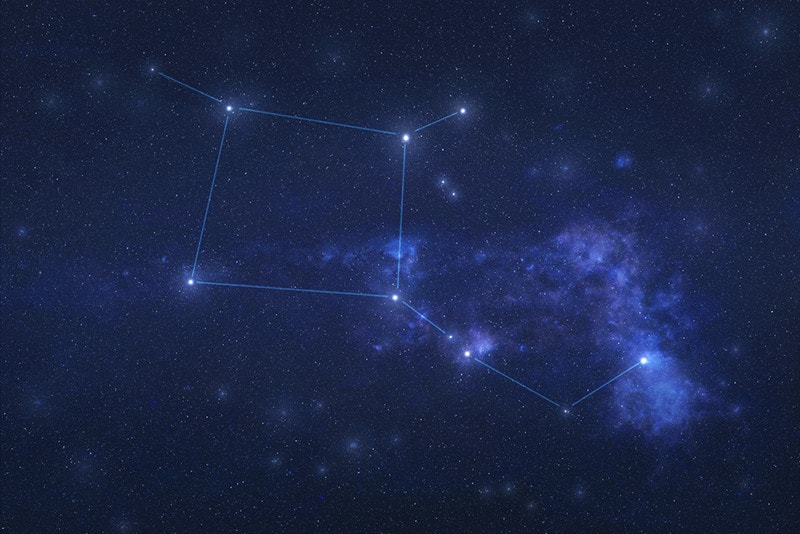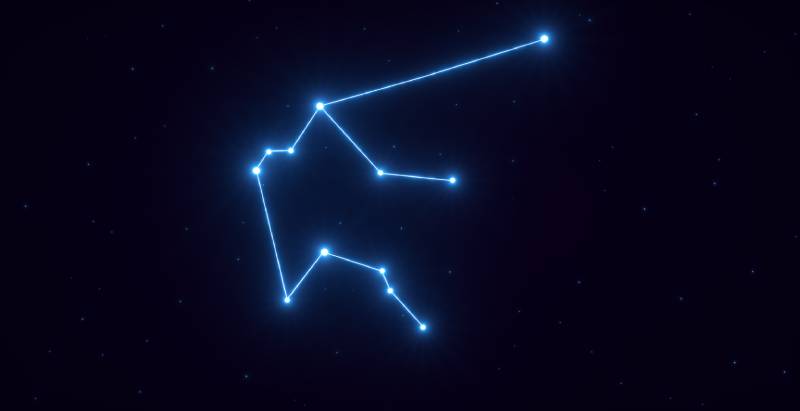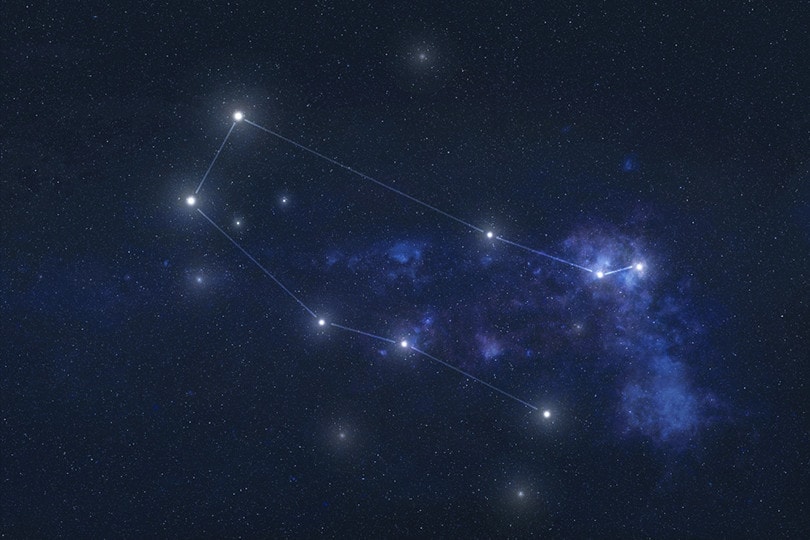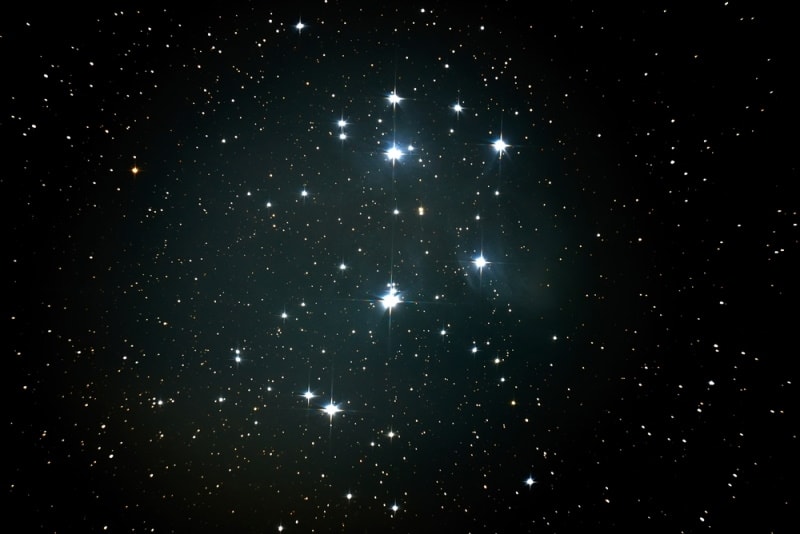What Are Constellations? Where Did They Come From?
Last Updated on

Constellations were an important part of many early civilizations’ cultures, and we still use them today when we check our horoscope or look up at the night sky. However, many people are unsure exactly what constellations are, so keep reading as we take a closer look at the constellations and share interesting facts to help you be better informed.

What Are Constellations?
Constellations are groups of stars that form a recognizable pattern in the night sky. The word constellation is Latin for “set with stars.”
Where Did They Come From?
Ancient farmers were likely among the first to use constellations to help them determine when to plant and when to harvest, as the constellations that we can see change throughout the year and repeat predictably. Early sailors also likely used constellations to help them navigate the sea. Some of the earliest writings regarding constellations are from 395 B.C.E. to 337 B.C.E. by a poet for the king of Macedonia. Also, 300 years later, between 100 C.E. and 170 C.E., Ptolemy, an Alexandrian astronomer, cataloged 48 constellations nearly identical to the ones that we use today. European astronomers added the remaining 40 constellations during the 17th and 18th centuries.

What Are the Different Constellations?
There are currently 88 different constellations in the night sky, and you can break them up into three categories: 21 northern constellations, 15 southern constellations, and 12 zodiacal constellations.
| Northern Constellations | Southern Constellations | Zodiacal Constellations |
| Andromeda | Ara | Aries |
| Aquila | Argo Navis | Aquarius |
| Auriga | Canis Major | Cancer |
| Bootes | Canis Minor | Capricornus |
| Cassiopeia | Centaurus | Gemini |
| Cepheus | Cetus | Leo |
| Corona Borealis | Corona Australis | Libra |
| Cygnus | Corvus | Pisces |
| Delphinus | Crater | Sagittarius |
| Draco | Eridanus | Scorpius |
| Equuleus | Hydra | Taurus |
| Hercules | Lepus | Virgo |
| Lyra | Lupus | |
| Ophiuchus | Orion | |
| Pegasus | Pisces Austrinus | |
| Perseus | ||
| Sagitta | ||
| Serpens | ||
| Triangulum | ||
| Ursa Major | ||
| Ursa Minor |

How We Use Constellations Today
Education
Constellations can be a great way to learn about the night sky. They provide a guide that students can use to locate other objects, like meteor showers, comets, and planetary alignments.

Astrology
Constellations are a big part of astrology, which is a belief that the alignment of certain planets, stars, and other objects can predict the future or reveal hidden information to the person reading these signs.
NASA
The stars that make up the constellations are moving, but they’re so far away that from Earth, they appear to remain fixed in position. Therefore, they make reliable landmarks for NASA when making changes in direction. NASA astronauts know how to navigate using constellations, and even robot spacecraft use maps of the stars to navigate their way through space. Constellations only appear to move on Earth because the planet is rotating and revolving around the Sun.

Other Interesting Facts About Constellations
- Besides the 88 accepted constellations, a German globe maker added two more in 1536, Coma Berenices and Antinous, which we no longer recognize.
- There were no southern constellations until 1589 when a Dutch astronomer named Plancius began to create them.
- The Greeks named many of the constellations after their mythological heroes and legends.
- Early sailors could determine how far north or south they were by using Polaris, the North Star, and Ursa Minor, the Little Dipper.
- Each of the constellations has a Greek story about its origin.
- Though the stars in a constellation can appear close together, their brightness depends on their distance from Earth and overall size, meaning many of the stars can be extremely far apart.
- You may only see a few constellations at a time depending on the season and where you are on the planet.
- Hydra is the largest constellation in the night sky.
- Crux is the smallest constellation.
- Twenty-two of the 88 constellations have names that begin with the letter C.
Notable Constellations
Aquarius

Aquarius is one of the original 48 constellations, and it’s also one of the 12 constellations of the zodiac. It’s quite large, spanning more than 980 square degrees, but it can be hard to see because there are no bright stars that stand out. The name is Latin for cupbearer or water bearer, and you can find it in the autumn season if you live in the northern hemisphere and during spring if you live in the southern hemisphere.
Cancer

Cancer is another member of the Zodiac constellation and has a Latin name that means crab. It’s one of the dimmer constellations, so it can be hard to find without help. It represents a giant crab that attacked Greek hero Heracles during one of his many labors, and you can find it in the night sky in early spring if you live in the northern hemisphere and in the fall if you live in the southern hemisphere.
Cassiopeia

Cassiopeia is one of the easiest constellations to find in the night sky. It has a characteristic W shape that stands out against the other stars and is named after the vain queen Cassiopeia, who angered Poseidon with her boasts about her beauty. He sent out a monster that almost attacked her daughter, but she was rescued by the hero Perseus. It’s easiest to see high in the sky near the North Star throughout October in the northern hemisphere.
Gemini

Gemini, another zodiac constellation, represents twins Castor and Pollux from Greek mythology. The brothers had different fathers but grew up together. When Castor was murdered, Pollock asked Zeus, his father, to allow him to share his immortality with his dead brother, and Zeus placed them both in the sky to become the Gemini constellation, where they could remain together forever.
Taurus

Taurus the Bull is one of the more popular constellations. It is easy to find due to its large red eye, one of the brightest stars in the sky. It also has a prominent V shape, representing the horns, and you will find it in the northern hemisphere from November to March, but it’s easiest to see in January, right after the beginning of the year.
Ursa Major

Ursa Major is a constellation that you likely know as the Big Dipper. However, the Big Dipper is only part of this large constellation. You can see it throughout the year in the northern hemisphere. Its name means Great Bear or She-Bear.
Ursa Minor

Ursa Minor is another popular constellation known as the Little Dipper. It contains Northstar Polaris, so it’s easy to find, but it can be easy to confuse with the Big Dipper. However, Ursa Minor is smaller than the Big Dipper and has an upturned tail. You can find it all year in the northern hemisphere, and it’s one of the most important constellations in the night sky due to its use in navigation.

Conclusion
Constellations are collections of stars in the night sky that form a recognizable pattern. These patterns helped ancient people navigate the sea and know when it was time to plant and harvest. Modern scientists still use them to navigate through space, and they are a central part of astrology. In total, there are 88 constellations: 21 northern constellations, 15 southern constellations, and 12 zodiac constellations.
Featured Image Credit By: Pike-28, Shutterstock
About the Author Ed Malaker
Ed Malaker is a veteran writer who contributes to a wide range of blogs covering information on computer programming, pets, birding, tools, fitness, guitars, and optics. Outside of writing, Ed is often found working in the garden or performing DIY projects in the house. Ed is also a musician, spending his time composing music for independent films or helping people repair their guitars.
Related Articles:
15 Crucial Facts About Ultraviolet Rays & the Sun
What Constellation Is Spica In? The Interesting Answer!
10 Interesting Leo Constellation Facts, Myths, and FAQs
15 Interesting Pegasus Constellation Facts, Myths, and FAQs
6 Interesting Sagittarius Constellation Facts, Myths, and FAQs in 2024!
8 Interesting Libra Constellation Facts, Myths, and FAQs
What Is Infrared Radiation? Science-Based Facts & FAQ
Is the Big Dipper a Constellation? Mythology, Facts & FAQs
